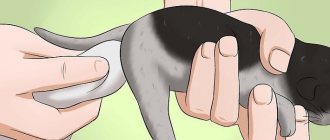Statistics on the number of pets in Russian families indicate that people are more likely to own cats. Moreover, fashion is becoming more popular, and even significantly exceeds the number of dog owners. This is not strange, because a cat is a little easier to care for. In order for a pet to become a true friend and not avoid a person, you need to accustom the cat to your hands. Options for classes can be different, although training is sometimes difficult. Basically, small predators are capricious, and some simply do not want to be held by their owner. We can try to correct this point.
Behavior of domestic cats
Interestingly, a kitten under the age of 6 months generally tends to follow its mother. A two-month-old pet must be under the supervision of a nurse. She teaches him hygiene, and also instills skills in interacting with the outside world. As soon as the animal grows up, it is time for its socialization into the human family.
In fact, domestication begins much earlier. The kitten will be inclined to affection if it completely trusts the person. This factor includes care, feeding, as well as calm communication and a good environment. You cannot scold a cat or raise your voice at him. If education is difficult, it is necessary to look for other methods. And for this, you need to know the reasons why the animal does not want to sit in your arms.
Recommendations for raising cats
- Eye contact.
The cat family has a negative attitude towards staring and the manner of looking eye to eye. Pets regard such behavior as a challenge and preparation for an attack. Regardless of your cat's age, do not supervise it closely. Observe your pet with peripheral vision without giving yourself away. If you are looking at a cat directly, blink smoothly and frequently, and do not keep your eyes open all the time. After time, your pet will appreciate the changes in your behavior and will want more attention. - Proper care.
A cat will grow up affectionate and loving only if it receives the necessary care from its owner. By nature, four-legged friends take care of each other. Your pet expects the same from you. The cat will appreciate the actions associated with slowly stroking its fur and scratching its neck area. Buy a comb, take care of the animal’s fur, while at the same time saying affectionate words in a quiet voice. If you notice a twitching of the tail, this means that the cat is tired of being handled. Reschedule procedures for another time. Purring and stretching will tell you that the pet is happy. - Treating yourself with a treat.
Make it a habit to carry a robe in your pocket and keep cat treats on hand. You can purchase a package of treats at a pet store or use homemade products based on your pet’s preferences. When the cat approaches you, give it a treat. Over time, the pet will get used to such actions and will be glad to be nearby. Give out double treats if your cat jumps into your arms. - Stroking.
When a cat gets used to the owner, his care, constant feeding of treats, display of restraint and patience, she is around more and more often. Be patient and monitor the animal's behavior. If your ward lies down next to you, placing her back or neck under your arm, do not skimp on stroking. With light movements, satisfy your pet's needs. At the slightest sign of dissatisfaction, stop manipulation. Affection should be in moderation. - Calmness and restraint.
If you recently brought a kitten into your home, adjust your behavior. Animals of this kind are afraid of sudden movements and loud sounds, especially if the person and the area are unfamiliar to them. Let the pet get used to its owner. Move smoothly, speak kindly and calmly. If possible, stay close to the cat as often as possible; it is not necessary to pick it up. Let the kitten come to you for a portion of tenderness and attention. - The direction of affection.
The cat family takes a long and persistent journey to begin to trust its owner. Many owners fail to achieve this even after 2-3 years of living together with their pet. If you are not one of them, having successfully made friends with your pet, follow the recommendations. When a cat comes to you for a portion of tenderness, you don’t need to grab it in your arms and pull it. Sit down next to him, scratch your tummy, neck, back. Let your pet rub its muzzle against you, stroke the bridge of its nose. Do not touch the cat in places where it is uncomfortable (paws, tail).
how to train a cat at home
Reasons for cats' withdrawal
Next, we will determine the factors influencing the behavior of your pet. We will also consider ways to correct behavior.
Among the most common reasons why cats do not go into the owner's arms are:
- Fear of the new owner. An animal at any age can show non-contact. On your part, we recommend that you try to slowly accustom your pet to people. If you adopted a cat from a cattery or were given it to you, it is possible that he was untamed from the very beginning;
- This behavior can be associated with bad memories of the pet. It happens that the previous owners threw the cat off their hands or did not treat it very well. But this is just one option;
- Uncomfortable position. The owner must understand how to pick up a kitten so that it does not feel scared or uncomfortable. Some cats don't always like the feeling of heights. This statement mainly applies to children. Such fear, by the way, can take hold in childhood and affect the pet’s subsequent reactions;
- To teach a kitten to sit in your arms, you need to find the most comfortable position for it. To do this, you can support your pet under the chest and hind legs. But sometimes, in order to pick up a cat, you need to set aside time and teach it to make contact on its own;
- The character of a cat that is accustomed to freedom, or since childhood, has not shown a desire to sit in a person’s arms.
If you want to teach your cat to be handled, try not to act against her will. When there are children in the house, explain to them that you must first make friends with your little pet and give her the opportunity to get used to the person. A young child may frighten the kitten, so their interactions need to be monitored.
Oriental cat
And although representatives of this breed are not the smartest, they are definitely the most sensitive and sensitive. It’s not for nothing that they are called telepaths of the cat world.
Oriental cats subtly and accurately notice even the most minor changes in the owner’s mood.
Cats always quickly and accurately find a sore spot and begin to quickly treat it with methods known only to the most mustachioed doctor.
The animals are very playful and temperamental, but this does not prevent them from quickly making friends with children and other pets.
What do experts recommend?
You need to gradually accustom your cat to human contact. It is very important that your pet feels comfortable and safe. To prevent the kitten from being scared of you, it is important to speak to it in a monotonous and soothing tone. Take a closer look at the following tips if you are faced with the need to accustom your cat to affection:
- Start with normal touching. Approach your cat several times a day and scratch it. At first she may get scared or run away. Usually, untrained animals simply show dissatisfaction. Short strokes with the spoken phrase “good boy” and other pleasant words can smooth out such a situation;
- Use a treat. Every pet has food that it is very partial to. At first, you can sit on a chair, taking a treat with you. Call your pet over to give him some food. Wait until he jumps into your arms. This method is good when the cat is already accustomed to your stroking;
- When a kitten has a favorite toy, you can try to interest him in such entertainment. You can use a soft ball, bows, and items purchased from a pet store. It is important that the item used does not damage the animal’s teeth and oral cavity;
- Teach your pet to eat from your hands. Right away you can simply give small pieces of food, and then feed and pet the animal at the same time.
The most popular methods for teaching a cat to be handled are listed above. Of course, it is necessary to take into account the individuality and uniqueness of each pet. Representatives of the cat family love to be taken care of. To reach this level of relationship with your pet, sometimes you need to try and be patient. But it also happens that a cat shows a friendly attitude towards some people, but is wary of others. In this case, we recommend that you resort to the same methods and give the kitten the opportunity to gradually get used to your loved ones. It is much more difficult to train an adult animal, since it has already formed certain patterns of behavior. In order to change your pet's habits, you need to develop a special approach to it.
Some training methods
If you are not one of those lucky people whose cats love to sit or even sleep in your arms, and you really want your pet to be “tame,” then you need to know that there are different ways to help tame this wild miracle:
- All cats love to eat tasty food, and it is better for a well-fed, dozing kitten to allow itself to be taken on your lap.
- An affectionate monotonous conversation with a pet encourages mutual communication. He, listening to the owner’s gentle speeches, will begin to squint and squint. In this state of mind, the pet will jump into the owner's arms.
- Animal psychology claims that a cat should get used to being handled gradually, in several stages. First you just need to pet her behind the ear, all cats adore this. Once the pet is near your palms, you do not need to grab it and hold it by force.
- You can act with the help of treats. At first, you can feed the kitten by hand, then put the yummy food on your lap. He will certainly jump after her. At the stage when your pet, having jumped up for a tasty treat, is in no hurry to jump back, but calmly eats it, you can try stroking it with your other hand. You shouldn’t hold him back by jumping on your lap over and over again; he will get used to it; giving him a treat will help instill in his master’s hands how to receive pleasure.
- If your cat is afraid of heights and weightlessness, then look at how correctly you are holding it and whether it is experiencing a feeling of pain. When lifting a kitten, you cannot hold it by the withers or by the body near the ribs. You need to hold the armpits of the front paws with one hand, and place the other under the hind paws. This way he won't feel like he's floating in the air.
- If the kitten is terribly afraid of heights, then first you can pick him up while sitting on your knees.
- Often the rapprochement between the owner and the cat occurs during play. At first, you can play with a bow or wrapper on the floor, gradually bringing the toy closer to your lap. As soon as the pet is in your arms, you need to let go of the toy and leave it under the full control of the animal. While he is enjoying the caught prey, he himself, without realizing it, is in his arms and at an unconscious level there is a period of adaptation.
- Some owners carry very small kittens in the pockets of terry dressing gowns; they sit there like kangaroos and get used to the owner’s smell. In the meantime, he will perceive the robe as his property, and the owner's smell will always be associated with the sweet period of childhood.
- As a last resort, pet stores have cat sprays with a high content of pheromones, which attract pets like a magnet. If you spray your palms with this miraculous method, the cat itself will reach out to you. You should not use this product often, because, against the background of pheromones, it will become addictive and then another problem will arise: how to wean your pet off cat spray. Catnip can be substituted for cat spray.
You need to understand that a kitten gets used to its owner’s hands faster than an adult cat; in the latter case, more patience will be required.
Knowing the free-thinking and independent nature of a cat, you can get along with your pet without much difficulty. If you still cannot achieve the desired result, then you need to leave it alone. After all, cats are quite characteristic animals, and character, as we know, changes throughout life.
Taming a kitten from the street
If you brought a pet from the street, you are faced with not the easiest task. The fact is that the baby may already be frightened by something and therefore his behavior seems wild. Taking a kitten into your apartment can be a very good idea. But it will take some time before he becomes tame and flexible. Depending on what the animal has seen, its domestication may span a different period of time. Sometimes it takes about two months for initial adaptation. During this time, the animal must be accustomed to the tray and feeding. If big problems arise, you can use special products that attract the kitten with a smell. You can determine a place for the kitten where he will rest. But most of all, owners love animals for their purring. Therefore, you need to try to get your pet to communicate with a person.
From the very first days of its appearance, the relationship between owner and pet begins to build. At this moment, it is important to show warmth and care to the baby. If the animal is very shy and hides from you, then place the food bowl where it will be comfortable. Then gradually move her towards the bedding or basket. Only after this can you teach the kitten to sit in your arms. But to achieve results, you need to continue to communicate with your pet step by step. You can take advantage of the advice from the experts we talked about earlier.
No matter what age your cat is, he needs to be given time to get comfortable. It is better to start hygiene procedures immediately, but carefully. This can also be stressful, so give the animal time to settle in later.
How to tame a pet
If you want to hold a furry pet in your arms at least sometimes, you need to make a series of efforts, and act slowly so as not to scare the animal away.
According to zoologists, cats, even adults, can be tamed if you are consistent in your actions.
We establish contact. First, you need to establish general contact with your pet - stroke its fur as often as possible, pamper it with healthy treats, and spend more time playing with it.
Training. As soon as the cat begins to communicate with pleasure with a person, you can train it to sit on your knees and hands, using the following recommendations:
- Give your pet his favorite treat by hand more often. In this case, the cat will form a causal-hereditary relationship, and the owner’s hands will be associated with something pleasant.
- Do not raise your voice near your pet, and do not laugh loudly. Cats don't like annoying sounds.
- Get interested in a glowing toy by placing it on your lap.
- Accustom it to hands when your pet has eaten a hearty meal. The fact is that the cat will be in a pleasant half-asleep and is unlikely to resist the additional warmth emanating from the owner.
- When you pick up your cat, you should immediately offer him his favorite food. As soon as the cat eats, it must be released. Having done this trick several times, the pet will be happy to be picked up on its own in the future.
- If a cat has a fear of heights, you need to tame it slowly, sitting on your knees, gradually rising higher.
- The training procedure should be carried out in a light playful manner. Toys on strings - bows, mice - are perfect for this. First, you need to properly “play” your pet, gradually moving the toy closer to your lap. In pursuit of the target, in excitement, the cat will jump onto its lap and not even notice it. By practicing such games more often, the mustachioed tabby will quickly get used to jumping onto his owner’s lap.
- While the pet is small, it can be carried in a pocket robe, like in a baby carrier. The baby will really like this fun, and he will perceive the robe as his property. An adult cat will associate the smell of a person on clothes with childhood.
- Talk more and calmly with your pet. The gentle, monotonous voice of the owner will calm the animal, giving a feeling of peace and security. If you stroke a cat at the same time as talking, it will quickly get used to close communication, begin to trust its owner and go to its knees for affection and attention.
Radical methods. If the above measures do not help, you can take an extreme step. Pet stores sell special aerosols that contain pheromones. These products will attract the cat. Just apply a small amount of aerosol on your palms, and your pet will always reach for them.
The use of aerosols has a disadvantage - there may be a problem in weaning the animal from the aerosol.
To help your cat get used to the smell of the product, you can use catnip. Accustoming an adult pet to handling is much more difficult; things will go faster with a kitten.
Is it worth taming a wild kitten?
People who want to have a purring miracle in their home often think about adopting a pet from the street. But many are afraid that a wild kitten, accustomed to life in the alley, will not be able to become obedient and affectionate. In fact, any wild cat can be made tame. The only question is how long the taming will take.
It is very important to tame a wild kitten in cases where you have already decided for sure that you are taking the animal to yourself. Aggressive cats, although not as dangerous as dogs, can also harm human health. In addition, it is necessary to tame a kitten if there are small children in the house who will definitely want to pet and hold the furry pet.
A wild kitten should only be tamed if you are going to take it home from the street
Balinese cat
This breed is also called the “Siamese with ermine mantle.” In addition to their beautiful appearance, animals are distinguished by their sharp mind. Cats can easily open and close any door, open drawers and find hidden objects.
Don't be fooled by the proud, arrogant and unapproachable appearance of the Balinese cat. They are very affectionate and friendly.
Cats of this breed love not only attention, but also long conversations with the owner, lying on his lap.
How to accustom a cat to being held?
Cats are not always tame and affectionate. Because of this, some owners are interested in how to accustom a kitten to being held, so that in the future the furry pet remains affectionate and always ready for human contact. Accustoming a cat to being handled when it is already an adult can be much more difficult, so this should be done with a kitten as soon as it settles in the house. In order to achieve success, you need to know certain rules of training, because otherwise, by making mistakes, you can get the opposite result and instead of a sociable cat, raise a wild animal that will react aggressively to attempts to pick it up.
Features of cat behavior
Owners who keep cats at home have long noticed that cats love to climb onto your lap. It seemed like there was no cat nearby, not even in the room, but as soon as your favorite sofa creaked, the fluffy ball was right there.
The first thing that comes to mind is that I came to beg for a tidbit. After all, a loving owner, touched by such attention, will definitely give his pet something tasty. But this conclusion is not always true.
Man began to domesticate cats thousands of years ago. The ancient Egyptians were among the first to do this. Their relationship was based on mutually beneficial conditions. In ancient Egypt, agriculture was developed, grain was harvested and stored in barns. It is clear that there was no end to small (and large) rodents. That's when the cat came to the rescue.
The benefit is obvious - the harvest is saved, the cats are fed, and the owners are happy. Moreover, each exists independently of each other. This basis for the relationship between a cat and a person has been preserved to this day.
Cats are often capricious, with their own hidden character, and they get used to a place rather than a person, considering themselves the main ones in the house.
Restricted areas
If your pet comes up to you to rub against your legs, do not yank him to pick him up. Remember, cats do not like to be deprived of their freedom and treated like a doll. Just gently call the cat to your sofa for petting. If she wants, she will come, and then you can caress her. But not all places on a cat’s body crave these caresses. There are areas, touching which alarms the animal and instinctively provokes it into aggression or escape. These areas include:
It is best to observe the cat’s reaction to your touch; over time, you yourself will understand which places it is better not to touch, and in which areas it is better to double the portion of strokes.
Main reasons
Cats are independent and freedom-loving by nature. But some of them love affection and happily spend time with their owner, others tolerate being petted, but run away at the first opportunity, and still others cannot stand any encroachment on their person and are ready to scratch and bite at any touch.
This can be explained by character traits, because, like people, each animal has its own. A cat can be unsociable and unsociable simply due to its temperament, and nothing can be done about it. But often dislike for affection has its own reasons.
- Your kitten is still small and has difficulty sitting in one place. He is interested in all the sounds, smells and movements around him, but it is impossible to explore the world while sitting on his owner’s lap.
- The owner smells bad. Cats cannot stand the smell of spices, garlic, lemon, tobacco, perfume, and alcohol. You can look like a dandy and smell like a Bulgarian rose, and at the same time be unpleasant for a cat. He would like it better if you didn’t drink, didn’t smoke, ate bland, simple food, washed without soap, did laundry without detergent, and always wore the same clothes.
- Memory of past grievances. If the kitten grew up on the street and did not see affection, or was beaten by the previous owner, or you yourself once offended him, the cat will not trust you and go to your arms. Yes, cats are very vindictive.
- Fear of heights. When you pick up a cat, he is suspended above the floor, and this can be very frightening for him. Try holding it under the armpits with one hand, and holding the hind legs with the other so that they have support. This will help the animal feel more confident.
- Fear and nervousness. Cats are afraid of sharp and loud sounds, screams and swearing. If there are constant quarrels, shouting and fuss in the house, the cat cannot relax and allow itself to be stroked. Even if it wasn’t him who was being scolded.
- Inconvenient surface. It may simply be uncomfortable for a cat to sit on your lap, because this “seat” sways and moves, which does not contribute to relaxation.
- Physical discomfort. Stroking can cause discomfort and even pain in a cat if you stroke it mechanically, many times in the same place. Also, during stroking, static electricity is generated, and when too much of it accumulates, the animal may become nervous, hence the aggression.











